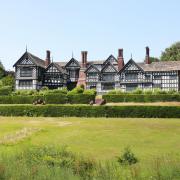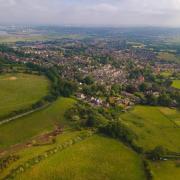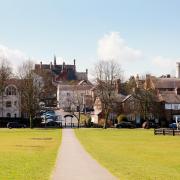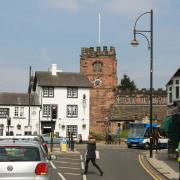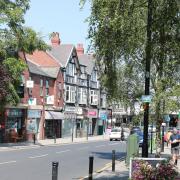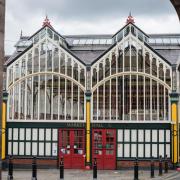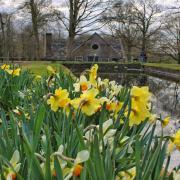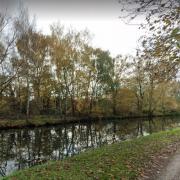Cheshire’s glorious Lovell Quinta Arboretum has 2,500 trees and plants

By Sara Walker
Towering over the Cheshire countryside is one of the county’s best-known landmarks, the famous radio telescope of Jodrell Bank, brainchild of physicist and radio astronomer Sir Bernard Lovell OBE FRS. What isn’t quite as well known, though, is that Sir Bernard who lived in Swettenham, just a few miles away from Jodrell, left a second legacy.
In 1948 he and his wife bought The Quinta, a large house on the outskirts of the village (quinta means country house in Portuguese). Shortly afterwards, Sir Bernard, a keen horticulturalist, began to develop an arboretum, buying up fields until it reached its present size of 28 acres.

His aim was to collect one of every type of plant listed in W. J. Bean’s Trees and Shrubs Hardy in the British Isles, published in 1914 and long considered the pre-eminent reference book to native woody plants. Today, the beautiful arboretum, now renamed Lovell Quinta in Sir Bernard’s memory, has almost a complete set of specimens with the exception of a handful, which could not be persuaded to grow in the local soil. In total, there are around 2,500 different species of plants.
Sir Bernard loved horticulture and was vice president of the Tatton Garden Society, which originally had its home in Tatton Park in Knutsford. When a new home was needed, Sir Bernard invited the society to move to the arboretum. In 2006, when in his 90s, he gifted the site to Cheshire Wildlife Trust to carry on his work. Realising that managing a formal arboretum was not in its area of expertise, the Trust regifted the arboretum itself to the Tatton Garden Society. The Cheshire Wildlife Trust remains responsible for the wilder woodland areas, and the two charities work closely together.
Now the arboretum is a beautiful, tranquil place of wide, grassy paths, sweeping avenues and horticultural surprises, with stunning vistas over the Dane Valley and the odd glimpse of the Lovell telescope at Jodrell.
Tatton Garden Society is currently under the direction of David Skidmore, emeritus professor of botany, who has been chairman for around 18 months. With him on the committee is Viscount Ashbrook, who has been the president of the Tatton Garden Society for around nine years and has a keen personal interest in gardening.

“I’ve spent the last 40 years or so creating a wooded garden at Arley Hall with a number of exotic trees and shrubs,” explains Lord Ashbrook. “I’m very keen on horticulture in an amateur capacity and that’s why I think that the arboretum is such an important place. The arboretum is a very valuable asset and I’m extremely keen that it should have the recognition it deserves.”
Sir Bernard’s family take a keen interest in the arboretum and daughter Judy still heads up the Lovell Quinta Arboretum Committee, which makes the decisions on budget and planning.
At the centre of the site is a large area of woodland, primarily made of up Norway planes and planted by Sir Bernard as the result of a Forestry Commission grant for timber. “Although it’s not of particular horticultural interest it’s one of the most popular parts of the arboretum for visitors, and you can often see dens in there made by children from fallen branches,” says David, laughing.
The arboretum has a large collection of conifers, held on behalf of the Royal Botanical Gardens in Edinburgh, which wanted a separate location in case disease or natural disaster should threaten the Scottish collection. You can also find two national collections (defined as containing 60 different species or more) – ash and pine.
“The ash collection is of particular interest,” says David. “Ash dieback, a disease caused by a fungus, is an active threat in Europe at the moment and our work here is helping us to discover which species have a natural resistance to the disease.” (The arboretum is part of the International Plant Sentinel Network, set up specially to help understand the spread and control of pests and diseases.)
Other interesting features include the birch avenue, which curves away along the edge of the arboretum framing views across the Dane Valley. Sir Bernard worked with the Russian Space Agency, and in 1976 saw the birch avenue at Tolstoy’s Yasnaya Polyana estate. Back home, he worked to create a similar effect at his beloved Quinta.
Many of the site’s notable features were planted to commemorate events in Sir Bernard’s life, such as the Reith Avenue and Knight’s Avenue, which run either side of the lake and were planted to commemorate Sir Bernard’s Reith lectures and his award of Knight Bachelor respectively.
The site is a charming maze of wooded copses and paths, but one man who knows his way around is curator Rhoderic Taylor.
“I’ve been working at the arboretum for around 22 years, first with Sir Bernard and then with Tatton Garden Society,” he says. “I took some students along and found that no-one was formally managing the site – Sir Bernard interviewed me for the role, and the rest is history. I think my favourite part of the site is the winter walk, which I planned and developed – it has a fascinating range of plants. I also love the oak collection developed by Sir Bernard, with its range of different shapes and forms.
“The arboretum has a wide range of botanical diversity and because it’s managed in an eco-friendly way it provides a haven for wildlife. It’s well worth a visit for its peace and tranquillity, the educational value and the splendour and range of plants on show.”
As well as the practical management of the plants, Rhoderic has also been responsible for carrying on Sir Bernard’s system of classification – albeit with a little help from modern technology. All the identification plaques now carry a code number giving the year of planting, as well as the Latin and common names of each plant.
Visitors will often see one of the team of 20 or so volunteers helping to keep the site looking trim. Eighty-two-year-old John Brewer has been volunteering for more tham 15 years and along with the rest of the team is responsible for everyday maintenance including mowing, pruning, planting, hedge laying, tree felling and weeding. “I like gardening, it keeps me young,” he says. “Outdoor activities keep you fit, and I enjoy the social aspect.”
Locals have always known how special the arboretum is, but more recently it has been enjoying wider recognition. “We’re delighted that we’ve just been awarded ARBNET accreditation, which puts us on a level with many other much larger organisations worldwide,” says David. “To get our Level 3 accreditation we not only had to have a large collection of species, but also to demonstrate an educational programme and organisation skills.
“There are very many benefits to taking a trip out to the Quinta Lovell Arboretum: stunning views, beautiful walks and it’s interesting for keen gardeners to see what will grow in the area. Many of our visitors appreciate it on many levels, and there is something different to see in every season, from snowdrops to autumn leaves. It’s a place that’s good for the soul.” u
The Lovell Quinta Arboretum, Swettenham Village, near Congleton, CW12 2LF.
For more information visit lovellquintaarboretum.co.uk. Dogs on leads welcome. Entrance £2.50. Visitors are welcome to park at the Swettenham Arms if staying on for a drink or food.
What to see and do atthe Quinta Lovell Arboretum in November
1. Stroll down the Golden Avenue with its autumn colours and see the acer rubrum ‘October Glory’ with its bright, gold leaves
2. The compact winged spindle shrub (euonymus alatus ‘Compactus’) is well worth a look for its intense red leaves and ornamental berries
3. The arboretum boasts a number of sweet gum trees (liquidamber styracifolia) and a Persian ironwood tree (parrotia persica) with a range of stunning autumn colours
4. Visit the oak collection, which is fascinating in autumn, especially the beautiful Shumard oak (quercus shumardii)
5. Autumn is the season of fruitfulness, and the ornamental crab apple trees (malus x robusta ‘Red Sentinel’) make a bright display
6. Admire the sweeping views over the Dane Valley on a crisp, sunny day – you’ll be surprised how far you can see





